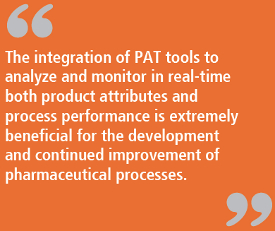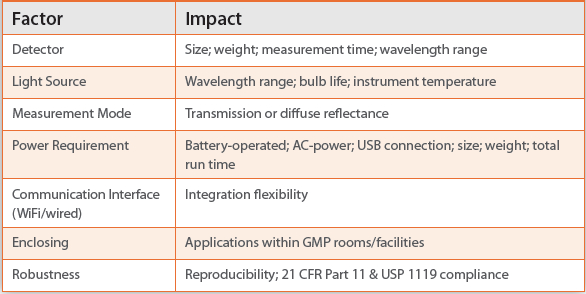With the advent of more portable spectral instruments, and in view of the Food and Drug Administration’s (FDA) latest article1 on its views towards continuous manufacturing, it may be time to focus on using miniature sensors to enable continuous manufacturing. In continuous pharmaceutical manufacturing, raw materials enter and drug products exit the process continuously, typically at a nearly steady rate. These streamlined manufacturing processes enable flexible lot sizes, short supply chains, and low overhead expenses due to smaller footprints. Process is scaled-up much more simply than batch counterparts, simply by running the process for a longer time. Moreover, continuous manufacturing processes can use initial and intermediate data outputs to consistently ensure high quality products. Compared to batch manufacturing, continuous manufacturing is uninterrupted, and requires that every process component be performed at the same mass flow rate, thus requiring advanced control architectures that are able to translate in real-time univariate and multivariate outputs to product quality whilst handling process and/or product variations. These control architectures require real-time multivariate interpretation of the outputs from Process Analytical Technology (PAT) tools, chemometric models, reduced order models, soft sensors, process parameters, etc.
The integration of PAT tools to analyze and monitor in real-time both product attributes (particle size, blend uniformity, hardness, density, impurities, dissolution, etc.) and process performance (feeding rate and blender speed variations, changes in residence time, compaction force, etc.) is extremely beneficial for the development and continued improvement of pharmaceutical processes. Adequate implementation of PAT tools enhances understanding and control of the manufacturing process. Outputs can be used to determine changes in residence time, predict critical quality attributes (CQAs) and monitor process robustness, as well as to construct process master curves for holistic control strategies.

One such PAT tool of choice is the near infrared (NIR) spectrometer. In the electromagnetic spectrum, the NIR region of 700-3000 nm constitutes a higher energy compared to far-infrared (Far-IR), but a lower energy than ultraviolet and X-rays. Compared to Far-IR, NIR probes vibrational modes from the ground to higher energetic states, known as overtones, and the combination of these vibrational frequencies into lower energy combination bands. Since all these energetic transitions are 10-100 times less probable than ground (fundamental) transitions, they give rise to weaker signals that do not easily saturate the detector. This facilitates analysis of physical and chemical properties without further sample preparation.
There exists a wide array of NIR spectrometers available. More recently, the development of fit-for-purpose miniature NIR instruments has made possible in/on-line monitoring of multiple unit operations, when just a decade ago this could only be imagined. For example, in batch manufacturing, multiple miniature units can be mounted on the outside of bin blenders so as to assess blend uniformity in real-time without the need for sample thieves. In a continuous manufacturing process, the NIR can be mounted at different stages so as to provide input to closed-loop controllers that ensure quality product.
 Figure 1. MicroNIR PAT Spectrometer.
Figure 1. MicroNIR PAT Spectrometer.In terms of instrument design and capabilities, the communication interface of the NIR spectrometer should not be overlooked. Wireless data transfer is highly advantageous for dynamic processes while hard wires need to be considered into the floorplan. GMP manufacturing facilities require that spectrometers be enclosed in explosion proof casings and comply with CFR 21 Part 11 and USP 1119. In that respect, as shown in Figure 1, miniature portable spectrometers prevail over bulky ones as it is easier to fit a smaller instrument within stainless steel-aluminum enclosures. These enclosures are usually designed to allow venting or negative heat flux out of the unit into the surroundings.
Thermal dissipation within the instrument is of utmost importance. Localized heat resulting from illumination sources and the detector can damage the optics of the spectrometer. It can also change the spectrum as temperature variations alter the power of emission bodies as described by the Stefan-Boltzmann law.2 This negative effect can result in spectral shifts, poor spectra reproducibility and low signal:noise ratios.
Table 1 lists some factors to take into consideration when choosing a NIR spectrometer for continuous pharmaceutical applications.
Table 1. Factors to Consider when Selecting an NIR

It is important to note that irrespective of instrument size, better hardware design translates into more robust spectrometers with smooth output signals that may not require extensive data preprocessing. At the present time, data preprocessing is heavily relied upon so as to filter non-linear multiplicative and additive effects resulting from path length or scattering effects. NIR spectroscopy has become closely integrated with chemometrics and latent variable methods so as to maximize the efficiency of the technique. Data deconvolution efforts result in adaptive model frameworks that can be continually improved whilst they are utilized for measuring in-process material/blend properties and CQAs.
For example, in a typical continuous direct compaction line for solid products there are three main unit operations: feeding, blending and tableting. NIRs can be mounted on all three of these process components for real time monitoring and/or feedforward/feedback controls based on: raw material identification and density predictions at the feeders, blend assay and homogeneity after the continuous blender [3], and tablet content uniformity and dissolution at the feed-frame of the tablet press. NIR outputs are then managed and supervised by PAT data management systems, aggregated with other types of data, analyzed, and translated into controlling actions on the manipulated variables. This cascading approach should ensure that the manufacturing process is in a state of control.
Based on the latest FDA recommendations,1 a continuous manufacturing process can exhibit one of three controlling strategies. Level 1 is an engineering control where process parameters are the manipulated variables and are adjusted as a function of immediate and propagating process variations. Level 2 is a pharmaceutically-relevant control based on design spaces of process parameters to ensure high compliance or low risk of failure for a quality attribute of the drug product. Level 3 is a tighter level of monitoring around target values for raw material attributes and in-process parameters.
Regardless of the level of implementation of process control, a fundamental understanding of the effect of the manipulated/monitored variable on the quality of the drug product is essential. PAT tools such as NIR spectroscopy can help in the implementation of any of these strategies. NIR spectroscopy would provide physical assurance that the inprocess and final product conforms to specs.
NIR for DOE Strategies Towards Process Design
An excellent approach towards the design and optimization of pharmaceutical processes is the utilization of design of experiment (DOE) strategies. These analyses, in combination with more fundamental modeling strategies, maximize the amount of information one may collect from a system by evaluating significant variable effects, interactions, trends and correlations. This information can be further utilized to enhance process understanding by defining design spaces based on tolerances or percent risk failure for CQAs, and construction of process models.
NIR can serve as a tool for measuring an intermediate or the final response in a DOE. If the response is blend uniformity, for example, extracting samples for off-line analysis is error-prone and disturbs the nature of the sample and sometimes even the entire blend.
On the other hand, an in/on-line NIR can give a real-time estimate of composition and homogeneity without delaying or disturbing the process. Total times to complete DOEs are significantly reduced in continuous manufacturing lines, and these advantages are further enabled by utilization of NIR.
NIR as a Validating Tool for Flowsheet Models
As mentioned before, continuous manufacturing processes are uninterrupted, so models that describe material passage through each unit operation, taking into consideration all process variations, are essential. Material traceability, as described by the residence time distribution (RTD) function, among other models, can be studied via integrated flowsheet models. Such models allow the evaluation of multiple processing strategies for continuous pharmaceutical processes of solid dosage forms. When combined with material attributes and engineering parameters, flowsheet models can lead to effective strategies for designing and optimizing continuous manufacturing processes. The models are used to test and empirically validate various feeding strategies, mills, blender configurations and/or processing methods and control architectures so as to propose scale-up strategies and predict process performance.4 NIR spectrometers can support flowsheet model validations with empirical data. For example, NIR provides real-time residence time measurements as a function of independent variable levels, e.g., formulation parameters, feeding rate, no. of blade passes, refill frequency, etc. Figure 2 shows how an unsupervised principal component analysis (PCA) line plot was utilized for real-time predictions of RTD at the blender exit when a step-change in the form of drug concentration was introduced to the process. The number for each sample can be further correlated to time based on the spectral measurement time.
 Figure 2. In-line NIR RTD predictions in a continuous manufacturing process following drug concentration step-changes.
Figure 2. In-line NIR RTD predictions in a continuous manufacturing process following drug concentration step-changes.NIR as an Enabler of Automatic Feedforward/ Feedback Control Systems
Automatic control systems that respond to process variations in real-time are desired for continuous manufacturing systems. NIRs have been utilized to test closed-loop control architectures when coupled with multivariate prediction models. At Rutgers University, spectral data from a miniature spectrometer has been utilized for several years for feedback control at the blending stage of a direct compaction continuous manufacturing plant for tablets.5 NIR output fed a supervised partial least squares (PLS) model that was integrated to the closed loop control architecture as shown in Figure 3. The results were used to test the performance of proportional-integral-derivative (PID) controllers versus hybrid model predictive controllers (MPC).
 Figure 3. Control architecture for a direct compaction continuous manufacturing plant with a miniature NIR sensor.5
Figure 3. Control architecture for a direct compaction continuous manufacturing plant with a miniature NIR sensor.5Conclusions
Pharmaceutical manufacturing is rapidly incorporating continuous processes. Coupled with science and risk-based approaches, continuous manufacturing can consistently ensure high quality products. Systematic assessment of the effect of changes in material attributes by reduced order models, in-process variations via PAT tools, and final process optimization by means of flowsheet models and DOE strategies will certainly lead to enhanced process and product understanding.
Fit-for-purpose miniature NIR spectrometers offer an advanced flexibility in terms of compliant designs and the robustness required for GMP manufacturing. Several applications of how NIR enables continuous manufacturing of solid dose products include assistance in DOE approaches, flowsheet model validations, and automatic closed loop control architectures. Portable spectrometers have many advantages, and we encourage pharmaceutical scientists to add them to their toolbox.
References
- Lee SL, O’Connor TF, Yang X, Cruz CN, Chatterjee S, Madurawe RD, Moore CMV, Yu LX, Woodcock J. Modernizing pharmaceutical manufacturing: from batch to continuous production. J Pharm Innov. March 2015: 1-9.
- Lerud R. Demystifying the black box: improving detection limits. NIR News. 2015; 26(3): 14-15.
- Colon Y, Florian MA, Acevedo D, Mendez R, Romanach RJ. Near infrared method development for a continuous manufacturing blending process. J Pharm Innov. 2014; 9(4): 291-301.
- Boukouvala F, Niotis V, Ramachandran R, Muzzio FJ, Ierapetritou MG. An integrated approach for dynamic flowsheet modeling and sensitivity analysis of a continuous tablet manufacturing process. Computers and Chemical Engineering. 2012; 42: 30-47.
- Singh R, Sahay A, Karry KM, Muzzio F, Ierapetritou M, Ramachandran R. Implementation of an advanced hybrid MPC-PID control system using PAT tools into a direct compaction continuous pharmaceutical tablet manufacturing pilot plant. Int J Pharm. 2014; 473(1-2): 38-54.
Author Biographies
Krizia M. Karry is a PhD candidate of the Department of Chemical and Biochemical Engineering at Rutgers University. Her thesis work is focused on the development and optimization of flexible continuous manufacturing platforms for delivery of poorly-soluble drugs. Krizia has extensive experience in the pharmaceutical industry, having worked for several years as a consultant in the area of process analytical technology (PAT) and chemometrics. She has presented at numerous conferences including the Eastern Analytical Symposium (EAS), International Forum on Process Analytical Chemistry (IFPAC), Excipient Fest and AAPS, and has won awards for her research presentations and advanced mathematical models. Krizia has coauthored several book chapters and scientific articles on process engineering and control, implementation and validation of PAT tools for real-time process monitoring, and novel techniques for drug delivery.

Dr. Ravendra Singh is an Assistant Research Professor of the Department of Chemical and Biochemical Engineering, Rutgers University, USA. He is the recipient of prestigious EFCE Excellence Award given in Recognition of an Outstanding PhD Thesis, from European Federation of Chemical Engineering. He is a recognized scientist in the field of continuous pharmaceutical manufacturing, process monitoring and control and has published 40 research articles in well reputed international Journals and magazines, wrote two book chapters and has given several invited industrial lectures and 68 presentations in international conferences. He is lead guest editor of Journal of Chemistry for PAT special issue.

Dr. Fernando Muzzio is a Professor II of Chemical Engineering at Rutgers University. He is the director of the NSF Engineering Research Center on Structured Organic Particulate Systems. The center, which has a total budget in excess of $10 million per year, focuses on pharmaceutical product and process design, with special emphasis on continuous manufacturing, particle engineering, and personalized medicine. FDA and 40 companies are currently members of the center. His research interests comprise powder mixing, mixing and flow of liquids and suspensions, and the development of continuous systems for pharmaceutical solid dose manufacturing. He is the author of over 200 peer-reviewed scientific articles and many book chapters and patents. He is a frequent advisor and lecturer at FDA events, and in 2010 he was appointed a voting member of the FDA committee on Pharmaceutical Sciences and clinical pharmacology.